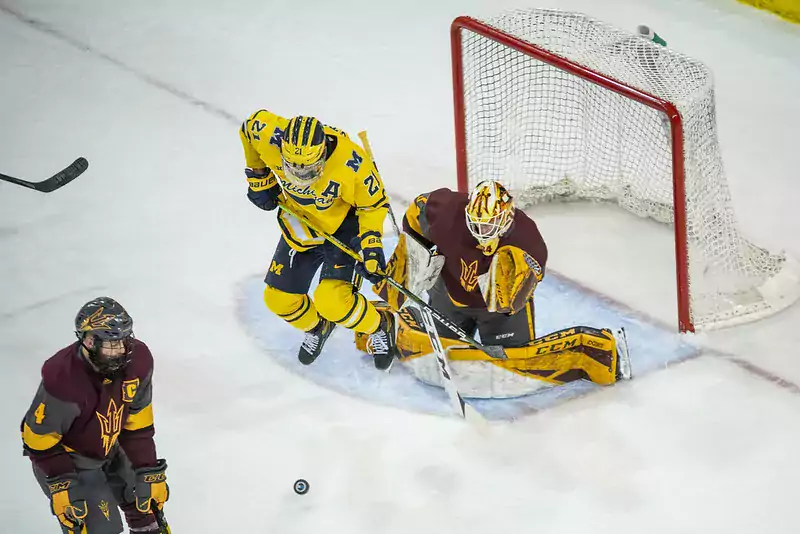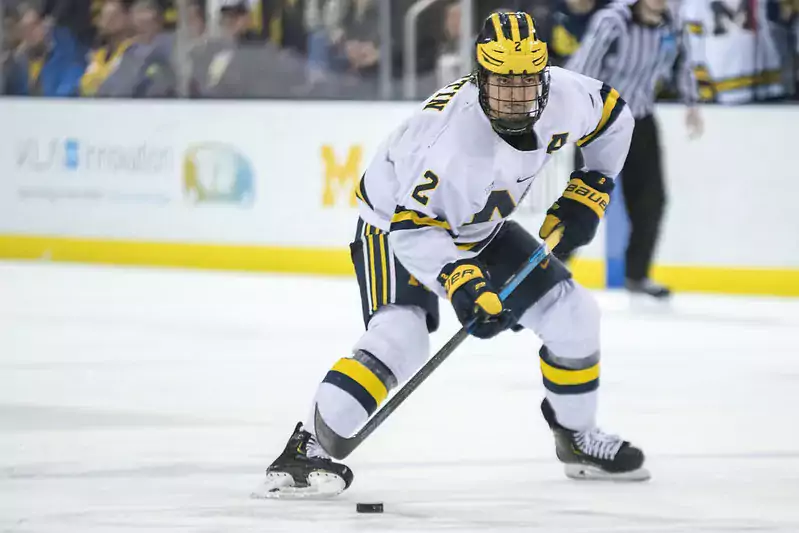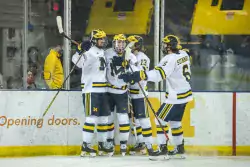learning hockey 2021

Learning Hockey, a Summer Series: Previously College Hockey 101, Nuts and Bolts 1: Transition Play, Nuts and Bolts 2: Forechecking, Nuts and Bolts 3: Power Plays, Nuts and Bolts 4: Penalty Kills, How to think like a Hockey Scout
Welcome back to the final addition of my 2021 summer series on teaching the finer points of hockey and its strategy. Over the course of this series we've covered the basics of NCAA hockey specifically, looked at strategy when it comes to transition play, forecheck alignments, PP's, and PK's, in addition to talking about how to scout players and what skills scouts look for. For this final post, I've assembled a mailbag by soliciting questions from readers, both through comments on some of my past pieces, as well as this post I threw up on the MGoBoard a week ago. I can't say I got to every question that was asked, but I did my best to respond to the ones that were either most frequently left, or the ones I found most interesting. I've also cited the usernames of who each comment was from (directly quoting in some cases, sometimes paraphrasing). I hope you all agree I did my best to get to as many questions as I could, and that my answers satisfy your desires:
"How do line changes work?" - Sue
Let's kick it off with this question. Teams are organized into lines and pairs of skaters: four lines of three forwards and three pairs of two defensemen. When a line or pair goes on the ice, it is referred to as a "shift". Any given shift is only going to last 45 seconds to a minute, typically, and line changes happen during the play in a free flowing manner. Players are rarely called back to the bench by a coach, but rather they have a general sense of timing in their head of when it's time to go for a change. After a long defensive sequence, players are going to be inclined to want to go for a change as soon as the puck leaves the defensive zone. Whenever there's transition play, with the puck either going from the DZ to the OZ or the OZ to the DZ, it's an opportunity for the teams to change. Typically the team with possession will go for a change, with one forward skating it up ice, allowing his defensemen and fellow linemates to go off, and after reinforcements arrive, he, too, will go for a change.
The coaches keep track of who is on the ice and will let the players on the bench know who is set to go on the ice next when the impending change comes. The best players are going to get more shifts than the lower caliber players as a general rule. When a line change happens during a play, the player exiting skates over to his bench and the player entering the game hops over the bench and onto the ice. However, that exchange can only happen when the player coming off is within five feet of the bench, which gives a little bit of leeway, and there will be a moment when both players are on the ice. The trick is, that neither the player coming off nor the player coming on can touch the puck while the other is on the ice, or that is a too many men on the ice penalty. This is why a warning bell goes off in the head of a hockey coach when the puck caroms towards the bench of his team while the team is in the midst of a change, because if any of the players touch the puck while the mass of bodies are switching, a penalty will be called.
[AFTER THE JUMP: A lot more questions and answers]

Learning Hockey, a Summer Series: Previously College Hockey 101, Nuts and Bolts 1: Transition Play, Nuts and Bolts 2: Forechecking, Nuts and Bolts 3: Power Plays, Nuts and Bolts 4: Penalty Kills
There was a rather humorous running joke on this past season's edition of the Michigan Hockeycast between David and I, where I routinely argued that I am not a hockey scout, which eventually morphed into me not being a scout of anything. While it's true that I'm not a water polo scout, an NFL quarterback scout, nor an archery scout, at this juncture, I am probably some degree of a hockey scout. I've watched enough hockey at the professional and collegiate level, and read the work of enough scouts for long enough, that I feel I have some amount of useful knowledge to lend to the MGoBlog community on how to scout the sport of hockey. So, I thought it would be useful to write up what I have learned about scouting as a capstone to my "Learning Hockey Summer 2021" series, tying together the strategy we talked about earlier and looking at the skillsets that individual players bring to the table, and talking about how to identify those skills.
This article will look at the different components of scouting, the skills and tools that scouts analyze. Typical scouting reports for draft prospects contain six different areas that the players are graded on: skating, shooting, passing, puck skill, hockey IQ, and physicality. I will walk through each skill and look at examples of players who excel at it and what scouts are specifically looking for when they evaluate each skill. And as part of the goal of this article, I hope that readers who are moderately unfamiliar with hockey become a bit more acquainted with some of the lingo that David and I use in our hockey posts. Skating will be first up.
[AFTER THE JUMP: skills, skills, skills!]

Learning Hockey, a Summer Series: Previously College Hockey 101, Nuts and Bolts 1: Transition Play, Nuts and Bolts 2: Forechecking, Nuts and Bolts 3: Power Plays
Part 4 of our Nuts and Bolts series will look at the penalty kill. Monday's piece took a look at power plays, and so today we handle the opposite. If you haven't read part 3, I'd recommend doing so, because this deep dive on PK's goes hand-in-hand with that one on the PP, and I will make references to that piece here. Penalty killing is an extremely important component of the hockey game, even if it is only a small sliver of the total time on ice. Teams with poor penalty kills can see all their hard work at 5v5 erased in the matter of seconds if they cede a PPG or two to the opposition. Michigan Hockey fans may remember the 2017-18 Michigan team, whose bid for a national title was dashed because the team consistently couldn't kill penalties effectively in big moments. Penalty killing is every bit as important as the power play, and good teams should also be at least competent on the PK to seriously threaten for a championship in their respective league.
Penalty Killing
Killing penalties is the flip side to power plays and it often involves a different set of players. Though some elite forwards and defensemen can play on both the PP and PK (Owen Power, Nick Blankeburg, Matty Beniers, and Thomas Bordeleau all play on both for Michigan), you often switch out some of those high skill passers and shooters for players with more refined skill sets, ones who can block shots, win faceoffs reliably, and battle in the corner for loose pucks. Relentless forechecking ability, size, and smarts are valued on penalty kills, and those forwards and defensemen not known for offense who play down in their team's lineup often appear on penalty kills, which in Michigan's case tends to be guys like Nolan Moyle and Garrett Van Wyhe.
Penalty killing is less schematic than some of our previous topics (forechecking, PP's), and so instead I'm going to just go through several components of the penalty kill and identify traits that come in handy and that coaches value when building their penalty kills, although there will be some strategic discussion.
[AFTER THE JUMP: Let's Kill Some Penalties!]

Nuts and bolts rolls along, and this time we discuss what happens when you have an extra screw in your pocket.

We're learning more about hockey, this time what to do when you don't have the puck but want it back.

Want to learn how college hockey operates? No? But it's offseason content, so you'll click on it all the same.
6